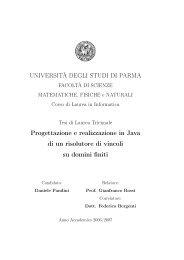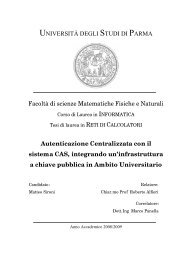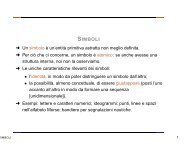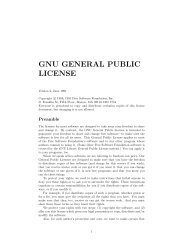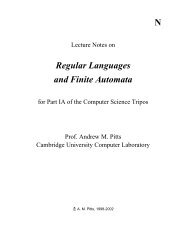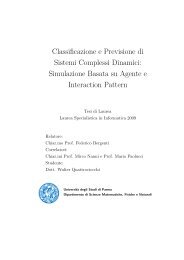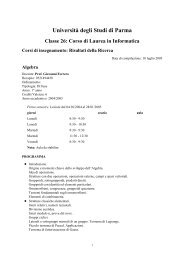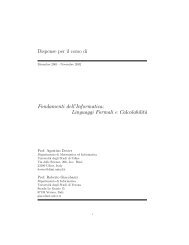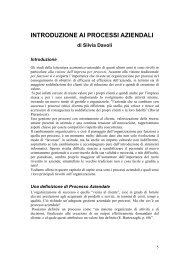a modern C++ library for the manipulation of Boolean functions
a modern C++ library for the manipulation of Boolean functions
a modern C++ library for the manipulation of Boolean functions
Create successful ePaper yourself
Turn your PDF publications into a flip-book with our unique Google optimized e-Paper software.
3.2.9 Combined search <strong>for</strong> entailed, disentailed and equivalent variables<br />
The algorithm equivalent_entailed_disetailed_vars_no_cache is used to find all<br />
equivalent, entailed and disentailed vars in a ROBDD by per<strong>for</strong>ming a single visit on it.<br />
The logic used <strong>for</strong> detecting entailed and disentailed variables is <strong>the</strong> same as <strong>the</strong> one <strong>of</strong><br />
<strong>the</strong> previous algorithm, while <strong>for</strong> equivalent variables we say that <strong>the</strong> equivalent variables<br />
<strong>of</strong> a ROBDD having its root labeled with variable x are <strong>the</strong> ones that are equivalent<br />
<strong>for</strong> both its true and false successors, plus <strong>the</strong> equivalences given by <strong>the</strong> fact that x is<br />
equivalent to <strong>the</strong> variables that are both entailed in <strong>the</strong> true successor and disentailed in<br />
<strong>the</strong> false successor. This statement has been proven in [BS98]. We must also consider <strong>the</strong><br />
fact that all entailed and disentailed variables are equivalent to each o<strong>the</strong>r: you can see<br />
how we handle this in Algorithm 7.<br />
Note that when whenever we compare <strong>the</strong> current variable with <strong>the</strong> maximum variable<br />
in a set, we are exploiting <strong>the</strong> ordering property <strong>of</strong> ROBDDs.<br />
3.2.10 Build a ROBDD representing some variable equivalences<br />
Given an equivalence relation L over Vars, <strong>the</strong> algorithm make_equivalent_vars can<br />
be used to build <strong>the</strong> ROBDD representing <strong>the</strong> <strong>Boolean</strong> function that is true if and only<br />
if ∀(x, y) ∈ L : x ⇔ y. We define <strong>the</strong> current variable xc and <strong>the</strong> set <strong>of</strong> true leaders T<br />
(it contains <strong>the</strong> leaders <strong>for</strong> L such that <strong>the</strong> branch <strong>of</strong> <strong>the</strong> ROBDD that we are currently<br />
building is reached only when all <strong>of</strong> <strong>the</strong>se leaders are true); <strong>the</strong> first is initialized to <strong>the</strong><br />
smallest variable in dom(L), while <strong>the</strong> second is initialized to ∅. The algorithm proceeds<br />
as follows:<br />
Step 1 If xc is undefined (which means that we have already processed all variables in<br />
dom(L)) return 1.<br />
Step 2 Let xn be <strong>the</strong> smallest variable in dom(L) that is greater than xc and xl = λL(xc).<br />
If xl = xc (xc is a leader <strong>for</strong> L) return <strong>the</strong> ROBDD having its root labeled with<br />
xc, its false successor being <strong>the</strong> result <strong>of</strong> <strong>the</strong> recursive application <strong>of</strong> this algorithm<br />
with xc = xn and its true successor being <strong>the</strong> result <strong>of</strong> <strong>the</strong> recursive application <strong>of</strong><br />
this algorithm with xn as <strong>the</strong> current variable and T = T ∪ {xc}.<br />
Step 3 O<strong>the</strong>rwise, if xl ∈ T , return <strong>the</strong> ROBDD having its root labeled with xc, its true<br />
successor being <strong>the</strong> result <strong>of</strong> <strong>the</strong> recursive application <strong>of</strong> this algorithm with xc = xn<br />
and its false successor being 0.<br />
Step 4 O<strong>the</strong>rwise, return <strong>the</strong> ROBDD having its root labeled with xc, its false successor<br />
being <strong>the</strong> result <strong>of</strong> <strong>the</strong> recursive application <strong>of</strong> this algorithm with xc = xn and its<br />
true successor being 0.<br />
3.2.11 Projection onto a set<br />
The algorithm project_set is used to compute f | X given a ROBDD representing f and<br />
a set <strong>of</strong> variables X. We start from <strong>the</strong> root and follow <strong>the</strong>se steps:<br />
3.2 ROBDD algorithms 19



